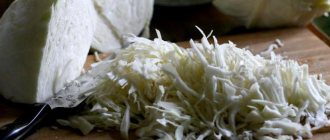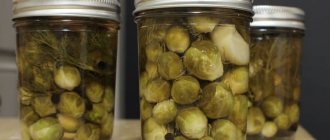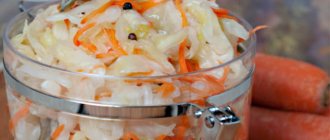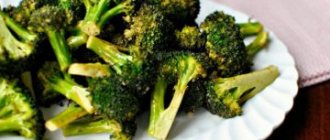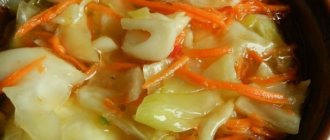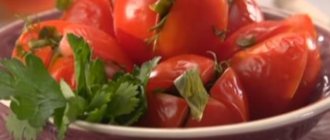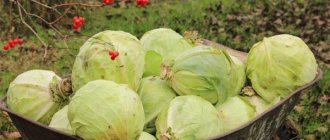Guests will sweep this cabbage off the table in one fell swoop! The recipe is very simple. This way you can prepare kim chi for the winter. For Koreans, kim-chi is the same as sauerkraut for Russians :) Cooking kim-chi is a very simple process. Another thing is that it lasts for several days. But it's worth it! I really love everything spicy, sour, salty - in general, tasty. I became addicted to Korean snacks when I was in the Far East. There, the diet of every Russian family includes Korean dishes; many have learned to cook themselves. That's why I cook kim chi quite often, but in small portions. I made it and ate it. Then, on occasion, I repeat.
- home
- Best Recipes
- Recipe categories
- Korean kimchi Beijing cabbage for the winter
Features of Chinese cabbage
Chinese cabbage contains acids, vitamins, minerals and fiber. By salting, you can preserve the beneficial properties of this vegetable for a long time.
“Beijing” strengthens the immune system, saves from vitamin deficiency, helps cleanse the body and normalize metabolism. It is included in the diet when fighting excess weight, diseases of the nervous system and heart, and hormonal disorders. The calorie content of such a snack is 15 kcal per 0.1 kg of product.
To prepare Chinese cabbage, you need to follow some nuances:
- When cooking, vegetables are not subjected to long-term processing;
- salting requires a long time, from several days to one month;
- It is not recommended to serve the snack with dairy products to avoid causing stomach upset.
Ingredients and how to cook
Only registered users can save materials in the Cookbook. Please login or register
ingredients for 6 servings or - the number of products for the servings you need will be calculated automatically!'>
Total:
| Composition weight: | 100 gr |
| Calorie composition: | 8 kcal |
| Belkov: | 1 g |
| Zhirov: | 0 g |
| Carbohydrates: | 2 g |
| Used: | 33 / 0 / 67 |
| H 100 / C 0 / B 0 | |
Cooking time: 40 min
Recipes for pickling Chinese cabbage
For pickling you will need Chinese cabbage and other vegetables (hot or sweet peppers, pears, etc.). Salt and spices are required. For a spicier snack, add ginger or chili pepper.
Simple recipe
The simplest pickling method requires only cabbage and salt. The cooking process in this case includes the following steps:
- Several heads of Chinese cabbage with a total weight of 10 kg are cut in any convenient way. If a large container is used for pickling, then it is enough to cut them into four parts. When using cans, you need to chop it into strips.
- Chopped vegetables are placed in a pan or jar in layers, with salt poured between them. The indicated amount of cabbage will require 0.7 kg of salt.
- Then boiled water is poured so that the vegetables are completely under it.
- Vegetables are covered with gauze and pressure is placed on top. The container remains in a cool place so that the cabbage does not sour.
- The gauze is changed every few days. After 3 weeks, the vegetables will be salted, then they can be transferred to jars.
Salting for the winter
To pickle Chinese cabbage for the winter, in addition to the main ingredients, you will need spices. The recipe is very simple and consists of the following steps:
- Cabbage (1 kg) finely chopped.
- Add salt (0.1 kg), bay leaf and cloves (2 pieces each) and allspice (4 pieces) to the chopped vegetables.
- The vegetable mass is mixed and compacted into a glass jar.
- The vegetables are covered with a piece of cloth or gauze on top, after which a load in the form of a small stone or a bottle of water is placed.
- The jar is placed in a dark place where the temperature is kept low.
- After a month, the snack can be added to your diet.
Pickling with pear
Cabbage goes well with fruit. If you add a pear when pickling, you can get tasty and healthy preparations. The recipe calls for green pears that are not ripe enough. Otherwise, the fruit pieces will fall apart during cooking.
- Cabbage (1 piece) cut into strips. The procedure is performed using a knife or grater.
- Pears (2 pcs.) are cut, seeds are removed and finely chopped.
- Mix the vegetables and remove them a little by hand. Add 4 tbsp to the resulting mass. l. salt.
- Then the vegetables are placed in a pan or jar, where 0.2 liters of water is added.
- Place the container in the refrigerator overnight.
- In the morning, the resulting brine is poured into a separate jar.
- Add grated ginger root (no more than 3 cm), chopped garlic (3 cloves) and ground red pepper (2 pinches) to the vegetable mass.
- Vegetables are poured with the brine obtained earlier. Now the blanks are left for 3 days in a warm place.
- After the fermentation process is completed, the pickled cabbage is rolled into jars and stored.
Korean pickling
In national Korean cuisine, there is a method of pickling Chinese cabbage using hot seasonings. This appetizer is an addition to side dishes and is also used for colds.
The following recipe will help you pickle Chinese cabbage for the winter in Korean:
- “Beijing” with a total weight of 1 kg must be divided into 4 parts.
- Place a pan on the stove, add 2 liters of water and 6 tbsp. l. salt. The liquid is brought to a boil.
- Vegetables must be completely filled with marinade and placed in a warm place.
- Chopped chili pepper (4 tbsp) is mixed with garlic (7 cloves), which is first passed through a garlic press. The components are mixed with the addition of water so that the mixture acquires the consistency of sour cream. The mass is left in the refrigerator for a day.
- Drain the brine from the cabbage and coat each leaf with a mixture of pepper and garlic. Ready vegetables are placed in a warm place for 2 days. You need to place a weight on top of the vegetables.
- Ready pickles are stored in a cool place.
Salting with spices
The use of various types of peppers and spices gives the preparations a piquant taste. This is one of the fastest salting methods. The cooking recipe is as follows:
- A head of cabbage weighing 1.5 kg is cut at the base, after which the leaves are separated.
- Each leaf is rubbed with salt (0.5 kg), after which they are placed in a container and left for 12 hours. You can start cooking in the evening and leave the cabbage to salt overnight.
- The leaves are washed with water to remove excess salt. The leaves have already absorbed the required amount of salt, so it is no longer needed.
- Then moving on to preparing the spices. Garlic (1 head) must be peeled and chopped in any suitable way. Hot peppers (2 pcs.) and sweet peppers (0.15 kg) are processed in a similar way, the seeds and stalks of which are removed.
- At the next stage, you can add dry spices to the dressing: ginger (1 tbsp), ground pepper (1 g), coriander (1 tbsp). To better distribute the spices among the vegetables, you can add a little water and dilute the dry mixture.
- Cabbage leaves are coated on each side with the resulting mixture, then they are placed in a storage container.
- The blanks are left in a warm place for several days; for the winter they need to be put in a cool place.
Read also: Do-it-yourself plastic cellar - my experience and my reviews, Do-it-yourself - How to make it yourself
Spicy pickling
A spicy snack called chamcha is a traditional Korean dish. For cooking you will need spices and sweet peppers.
The cooking recipe includes several steps:
- Fill the pan with 1.5 liters of water, add 40 g of salt. The liquid must be heated to a boil.
- Peking cabbage (1 kg) is cut into strips 3 cm wide.
- The resulting brine is poured over the chopped vegetables, a weight is placed and they are left to cool in a cool place.
- After the vegetables have cooled, the oppression is removed, after which the vegetables are left in brine for 2 days.
- After the specified time, the brine is drained and the cabbage is squeezed out by hand.
- Chili peppers (4 pcs.) are cleared of seeds, add one clove of garlic and grind in a blender.
- Sweet pepper (0.3 kg) needs to be cut into strips.
- The vegetables are mixed in one container with the addition of soy sauce (10 ml), coriander (5 g), ginger (10 g) and black pepper (5 g).
- The resulting mass is left for 15 minutes.
- Then it can be put into jars for storage.
Pickling with vinegar
For the winter, you can pickle Chinese cabbage with vinegar to extend its storage time. The following recipe shows how to pickle vegetables:
- Pour 1.2 liters of water into the pan, add salt (40 g) and sugar (100 g).
- When the water boils, add 0.1 liters of apple cider vinegar to the pan. The brine is left to boil for another 15 minutes.
- The head of cabbage is cut into large pieces.
- Bell pepper (0.5 kg) cut into strips.
- Onions (0.5 kg) need to be cut into rings.
- Hot pepper (1 pc.) is cleared of seeds and finely chopped.
- All vegetables are thoroughly mixed and placed in jars.
- Hot brine is poured into each jar.
- Then you need to roll up the jars and place them in a cool place for the winter.
Vegetable pickling
Chinese cabbage goes well with peppers, carrots, daikon and other vegetables. The result is a healthy snack packed with vitamins.
The following recipe is used for salting vegetables:
- A head of cabbage weighing 1 kg is cut into four parts.
- Cabbage leaves are rubbed with salt, after which they are placed under a load for 7 hours.
- Pour 0.4 liters of water into the pan, add rice flour (30 g) and sugar (40 g). Place the mixture on low heat and cook until it reaches a thick consistency.
- Then they move on to preparing the spicy paste. In a separate container, chop garlic (1 head), chili pepper (1 piece), ginger (30 g) and onion (50 g).
- Grate daikon (250 g) and carrots (120 g), then place them in the filling, where you need to add 30 ml of soy sauce.
- The salted cabbage is washed with water, after which each leaf is coated with spicy paste and placed in a pan containing the filling.
- Cover the container with a lid and place on low heat.
- After boiling, the snack is placed in jars.
Step-by-step preparation
Step 1:
First, we free the head of Chinese cabbage from the top (spoiled, wilted) leaves. It is better to take large heads of cabbage, because the crunchiest and juiciest parts are not the leaves, but their base, what we cut off from ordinary cabbage.
Step 2:
Cut the head of cabbage lengthwise into 4 parts. Place the cut pieces into a large container. Let me note right away: the mixture of pepper and garlic is a thermonuclear thing and the smell is absorbed into the container once and for all. Therefore, the options are as follows: take a large enamel pan or select a plastic container that you will use specifically for salting kim chi.
Step 3:
Now let's prepare the brine. I usually pour boiling water over a measured amount of salt and stir it until completely dissolved.
Step 4:
Pour the cooled brine over the cabbage
Step 5:
I cover it with a plate so that the cabbage is always in the brine. In this form, leave the cabbage to salt at room temperature for 10-12 hours. I usually salt it in the evening and finish cooking in the morning. After 5 hours, you can turn the cabbage over so that all the leaves are salted evenly.
Step 6:
When the cabbage is salted, prepare the pepper mixture. Measure out 4 tbsp. hot pepper. I take Korean, ground into large flakes.
Step 7:
Squeeze 6-7 cloves of garlic into the pepper, add 1 tsp. Sahara.
Step 8:
Add a small amount of water (about 2-3 tbsp) to make a thick paste.
Step 9:
Now we put on GLOVES (!), take one piece of salted cabbage and coat each leaf with pepper gruel. Then there are 2 options: put it back into the empty pickling container, pour in a little brine, put pressure on it so that the juice stands out; or place tightly in glass jars, pour in a little brine, and close with a lid. In any case, we put the cabbage in a cool place: underground, balcony, refrigerator. After a couple of days, the cabbage is ready.
You can store it in this condition all winter, the main thing is that it is in brine, otherwise it will rot.
How to eat kim chi? Kim-chi is served as one of the appetizers for any Korean dish (usually there are 3-4 of them in small bowls). The easiest way is to get ready-made cabbage, lightly rinse it from the pepper (if it’s very spicy for you), cut it crosswise into wide ribbons, and pour in vegetable oil. This is a Russian version :)
It is also very tasty to cook meat with kim chi. I won't put this in a separate recipe because the preparation is very simple. The pork needs to be cut into small pieces, fried with onions until almost done, then add chopped kim chi and finish. You can add a little water and simmer. The dish turns out very tasty.
Beijing or Chinese cabbage is no less beneficial for the human body than white cabbage. However, it is softer and more delicate. This vegetable cannot be stored for a long time. To be able to consume it throughout the winter, you can prepare the preparations at home in various ways. Simple and tasty recipes for salted Chinese cabbage are collected in the article.
Read also: How wine ferments photo
How to properly salt Chinese cabbage? Several simple and quick cooking recipes
If you prepare Chinese cabbage according to various recipes, it turns out very tasty and tender, despite the fact that cooks add pepper to it. Below will be listed the best recipes for how to salt a Chinese vegetable quickly and easily.
In the article you will find recipes for pickling spicy Chinese cabbage with garlic and pepper, with vegetables, spices, vinegar and even with pear. Try it and choose the best one for yourself! You will also learn the secrets of how to preserve this dish for a long time and what it can be used with.
Features of storing workpieces
Salted and pickled foods that have not undergone the preservation process should be stored exclusively in cold conditions - in a cellar, basement, or refrigerator. Shelf life is 3–4 weeks. A product that has undergone the canning process can be stored at temperatures from 0°C to +20°C. Preservation should be in a place where the rays of the sun do not penetrate, where there is low humidity and there are no sources of heat.
Peking cabbage is easy and simple to prepare at home. If you follow the dosages and recipe instructions, you can make excellent nutritious snacks that can be served at lunches, dinners, and during feasts throughout the winter.
Chinese cabbage has the same beneficial properties as white cabbage. But preparing it for the winter is easier and its taste is more delicate and soft.
It does not produce tart juice, which is good for almost everyone to drink. Let's find out how to properly salt Chinese cabbage. If you like spicy Chinese cabbage, recipes for cooking cabbage can be found here.
Features of the product composition
One of the main advantages of this product is the presence of vitamin C in the leaves. Thanks to it, eating the vegetable minimizes the effect of stress on the body, which successfully fights depression and maintains a good mood. In addition, Beijing contains a huge amount of macroelements, microelements and vitamins that have a beneficial effect on the body.
By including cabbage in your diet, a person copes with vitamin deficiency in the spring. There are many recipes that can be prepared from Chinese cabbage. But in order to make not only a tasty, but also healthy dish, you need to familiarize yourself with the nuances of preparation.
Nuances of cooking
When cooked, ascorbic acid (aka vitamin C) is destroyed. Therefore, Pekinka can be used for pickling, consumed fresh, pickled and pickled. There are some subtleties in preparing the product in all these types:
- For cooking, cutting vegetables is different from the usual. Beijing should be cut into rectangular pieces, 4x4 or 2x2 cm in size. Or better yet, don’t even cut it, but tear it off with your hands, without using a knife.
- At the base of the head of cabbage, the leaves must be separated correctly, because that is where they are the juiciest.
- If the recipe calls for other vegetables, cut them into thin strips. You can use a special grater to prepare vegetables in Korean.
- In order for sauerkraut or pickled cabbage to be stored longer, it is better to place it in pre-sterilized jars.
- Storage temperature should not exceed 12 °C.
- Nitrates accumulate in the heads of cabbage during growth. You can get rid of them by placing the leaves in a bowl of cold boiled water for 1 hour and then shaking.
- Salt in salads and appetizers can be replaced with soy sauce.
Salad Recipes
There are a great many salad recipes. Beijing can be combined with various products, including a meat product (chicken, ham or sausage). Then there are continuous experiments at the discretion of the hostess.
With corn, croutons and beans
To prepare you will need:
- Beijing - 1 head;
- canned corn - 1 can;
- canned beans - 1 can;
- crackers - to taste;
- garlic and mayonnaise (easily replaced with vegetable oil) - to taste.
Cooking sequence:
- pour corn into a container;
- add beans;
- cut the Chinese cabbage (divide with your hands into pieces approximately 2x2 cm in size);
- add cabbage to remaining ingredients;
- sprinkle the crackers. They need to be added immediately before use to prevent them from getting soggy;
- Sprinkle garlic on top, mix with mayonnaise or pour over vegetable oil.
With cheese and chicken
To prepare you will need:
- Beijing - 300 grams;
- chicken fillet - 300 grams;
- hard cheese - 200 grams;
- crackers - 200 grams;
- ground black pepper to taste;
- mayonnaise - 100 grams;
- salt to taste (can be replaced with soy vinegar).
Cooking sequence:
- cut or separate pekin leaves into square pieces by hand;
- cut cooked chicken fillet into cubes;
- grate hard cheese on a coarse grater;
- mix everything, add pepper and mayonnaise.
The dressing will be more tender if the mayonnaise is half mixed with sour cream.
Chinese and Korean snacks
The proposed recipes for Peking appetizers are perfect to serve during the cold season, when you cannot pick fresh vegetables from the garden. But it is not necessary to store all this in the cellar until winter; the dishes offered are worthy of being consumed immediately after preparation.
Salted Chinese cabbage
To prepare you will need:
- Chinese cabbage - 2 kg;
- salt - 1 glass;
- allspice - 10 pieces;
- bay leaf - 2 pieces;
- cloves - 5 branches.
Cooking sequence:
- cut the cabbage into even strips;
- add salt, bay leaf and other spices. Mix well;
- Fill the jars with cabbage, compacting slightly. Cover with natural fabric;
- press down with something heavy;
- Place in a cool, dark room.
To try to see if it turned out delicious, you will have to wait at least a month.
If you want to stock up on such a snack for the whole winter, then for every kilogram of cabbage you should add additional salt - in the amount of 100-120 grams.
Original spicy snack
The Korean snack chumtat in Korea is prepared with a lot of pepper. That's why Koreans don't use it alone. It must be served with a side dish. But in this recipe you can add pepper to your taste.
To prepare you will need:
- Chinese cabbage - 4 kg;
- onions - 4 pieces;
- garlic - 4-6 cloves depending on the size of the clove;
- ground red pepper - to taste;
- salt - 60 g or 2 heaped tablespoons.
Cooking sequence:
- cut the cabbage into even strips;
- add salt. Mix;
- leave for 3-4 hours (if the kitchen is warm) or 5-6 hours (cool);
- cut the onion into half rings, chop the garlic using a garlic chopper;
- add onion and garlic to the container with cabbage;
- sprinkle with pepper. Stir;
- after this, the prepared sauerkraut with seasonings must be placed in a glass or enamel container, pressing down with a weight on top. Leave for 2-3 days;
- When the appetizer is ready, transfer to glass jars, cover with lids and put in the refrigerator for storage.
Salty Kim-chi for the winter
A step-by-step recipe for Korean-style Chinese cabbage is an excellent winter snack. In addition, this snack retains all the beneficial properties of the vegetable. The dish has a spicy, refined taste.
To prepare you will need:
- Beijing - 2 kg;
- chili pepper - 2 medium sized pods;
- garlic - 3 large heads or 15 cloves;
- salt - 7 tablespoons;
- cold water - 2 liters.
How to salt cabbage in Korean:
- Cut each head of cabbage into four equal parts and place them in a deep container;
- boil water, dissolve 5 tablespoons of salt and pour the brine into a container with cabbage;
- cover the pan with gauze and place in a warm place for a day;
- Mix the remaining salt with pepper and chopped garlic, add water and stir until a paste is obtained. Leave to chill in the refrigerator;
- 24 hours later, drain the brine into an empty container for further use. Coat the Peking leaves with the prepared gruel and fold tightly into a convenient container under pressure;
- leave in a warm place for two days;
- after two days, remove the cabbage leaves from under the load, add a little of the saved saline solution and place in the refrigerator without pressure;
- let it sit for several days, although the tasty and fortified dish can be consumed immediately.
Canned snacks
Recipes for Chinese cabbage for the winter are especially popular among housewives. Properly fermenting Pekinka at home is as easy as shelling pears. But the result will exceed all expectations. This dish will please everyone in the household in the winter.
Marinated winter snack
To prepare you will need:
- two heads of Chinese cabbage - approximately 1 kg;
- salt - 6 tablespoons;
- sugar - 4 tablespoons;
- vinegar - 200 ml;
- black pepper - 6 peas;
- water - 1 l.
Cooking sequence:
- Carefully cut the cabbage into strips;
- to prepare the marinade, add salt, sugar and vinegar to the water;
- Place peppercorns and cabbage one by one into sterilized jars and compact slightly;
- pour in the boiling marinade and roll up the lids;
- Cover the inverted jars with a towel until they cool completely.
Storage at home
Required components:
- 2 kg cabbage;
- 0.5 kg carrots;
- 200 gr. garlic;
- 5 gr. chili pepper;
- 8 gr. bay leaves;
- 200 ml oil;
- 1 liter of water;
- 15 ml vinegar;
- 50 gr. salt;
- 200 gr. Sahara.
We invite you to read: Cabbage makes breasts grow: truth or myth?
Preparation progress:
- First, wash and cut the cabbage into thin strips.
- The carrots are thoroughly peeled and cut into strips or grated on a Korean carrot grater.
- The garlic is chopped.
- Vegetables are mixed and placed in jars.
- Add all remaining unused products to the water and bring the liquid to a boil.
- Pour hot liquid into jars and roll up the lids.
- The container is wrapped and, after cooling, placed in the refrigerator.

